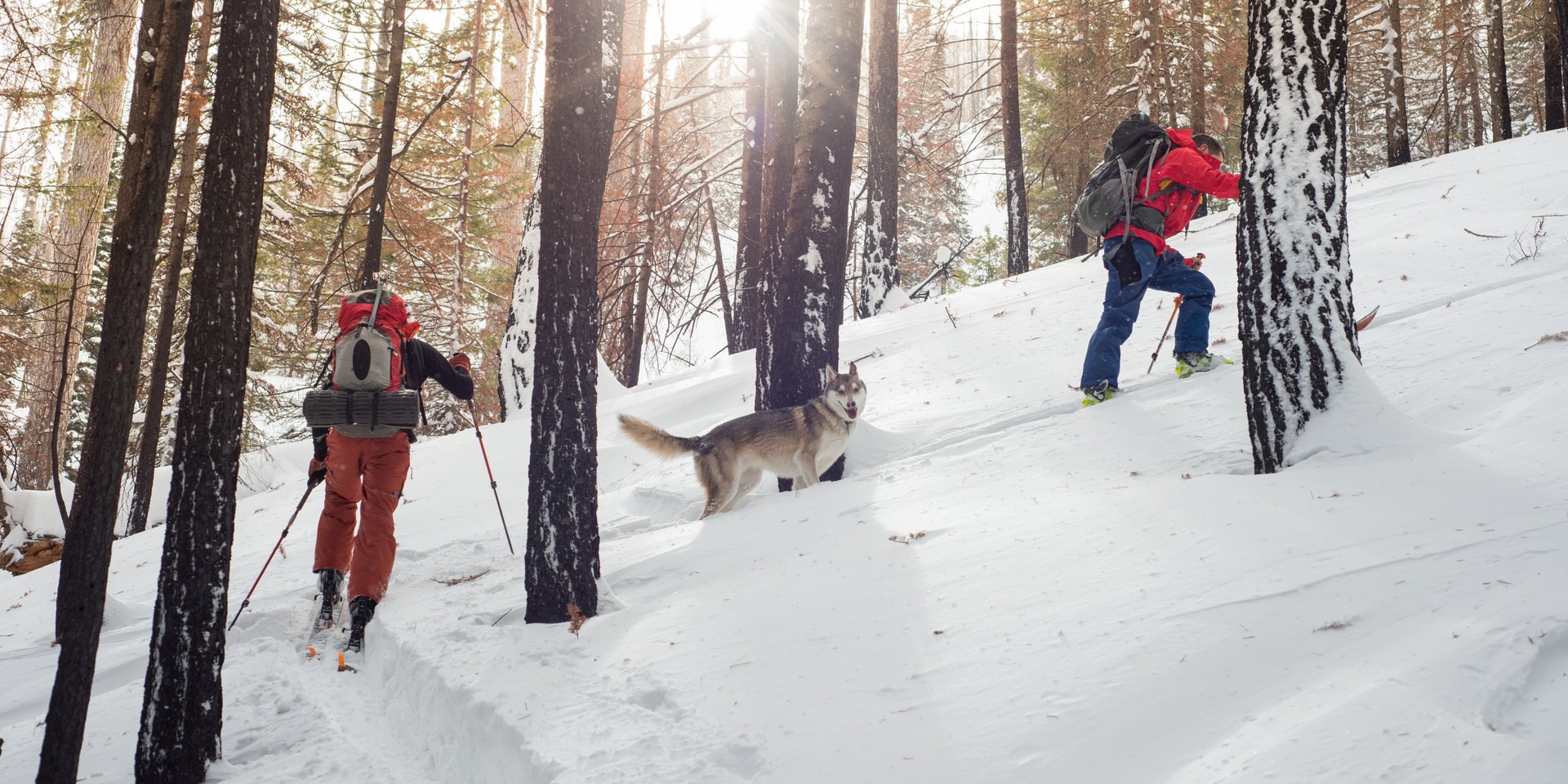You are here
We’ll air our bias outright and confess: We’re diehard dog people. For us, watching our pups celebrate the first snow of the season is, year after year, one of our very favorite things to do. It’s second only, perhaps, to an untracked, low-angle powder field and that same pup bounding through the backcountry, hot on our tail.
There are plenty of opinion pieces you could dig up that feature disgruntled, staunch opponents of dogs in the backcountry. We’re not here to say their opinions and experiences are not valid, but we aim to build an inclusive, supportive community centered on environmental stewardship, empathic etiquette, and safety and fun for all (two and four-legged creatures alike). This—first and foremost—necessitates a true, honest assessment of your dog’s abilities and behavior, as well as the preconceived notions you bring to the table before you leave the safety of the snowy parking lot.
Before we get into the more nuanced list of what a thriving backcountry dog needs before you embark, it’s important to note that introducing a dog to any backcountry activity should happen gradually, deliberately, and in safe, low-consequence situations with simple, straightforward exit strategies. Likewise, consider the principles of Leave No Trace before you leave the trailhead and always be sure to pack accordingly.
Specialized winter gear considerations
It should go without saying that not all breeds are naturally suited to snowy adventure. Consider the evolutionary origins of your pup: a golden retriever or Newfoundland will usually delight in miles of snowy wonderland but might need paw protection; a pitbull or a vizsla will usually have the stamina and enthusiasm but might need an extra layer of warmth. Consider this short checklist:
- Musher’s Secret Wax: This paw wax is designed to protect the little furry spaces in between paw pads from accumulating painful snowballs. Plus, it’s all natural, highly moisturizing, and actually helps your dog’s traction.
- Ruffwear Grip Tex: Most dogs don’t need booties, but if the paw wax simply won’t work for your pup, this pair is at the top of the pack. This is the only pair we could find with a truly non-slip Vibram sole and superior warmth.
- WeatherBeeta 300D Deluxe Reflective Parka: A shivering dog is a scary sight in the backcountry. It’s better to be safe with a doggy parka than sorry. This one is best in warmth, durability, and it will stay in place.
The beacons debate
On a ski touring day, you would never even consider leaving the parking lot without turning your beacon on and methodically testing those of your friends. While there are plenty of dog-specific beacons and GPS pet trackers out there that can be great for hiking and low-consequence snowshoeing, you should NEVER put a beacon on your dog during situations in which humans are wearing beacons for avalanche precautions. Never risk saving a dog’s life over a human’s life.
Training for ski travel
Every backcountry ski community is rife with horror stories featuring dogs and sharp ski edges. It’s true, dogs that don’t understand how to stay in a safe space when you start sliding downhill can be in great danger. Many who have experienced this type of accident admit to never again being able to adventure with their dog on uneven terrain. That’s a worst case scenario, but it’s far from the only ending to a backcountry ski story.
Prepping your pup for a tour first and foremost means setting a solid baseline for stamina and training them to always, always stay behind you. This truly takes time, and many people report success using bikes and rollerblades (yes, rollerblades) as training tools. Once you can get your fired-up pup to consistently stay behind you and check speed accordingly while listening to commands like “other side” and “wait,” you’ll be a significant step closer to a successful tandem ski mission.
Knowing where to go
Steep terrain and avalanche-prone slopes are a definite no go with dogs. The reality is that only a small fraction of terrain you are able to ski is also suitable for a pup. This is, in part, due to the objective limitations of a dog (no matter which one) in snowy terrain. The more significant part, though, is that a dog represents a variable into a highly sensitive situation.
Ski touring and backcountry travel in general is rife with hazards, life threatening and otherwise. Even the most experienced, well-trained dog can be a dangerous addition to a sensitive snowy scenario. There are far too many stories that involve dog-triggered avalanches.
While every person, dog, and scenario is different, it’s best to stick to low-angle, forested slopes and under 5 inches of fresh snow when you’re considering bringing your pup. Most importantly, be sure to communicate empathetically and clearly with all members of your party—not everyone feels comfortable skiing in a group with a dog, and human safety should always come first.





Comments
Sign In and share them.